Author's posts
May 12 2010
May ’70: 12: The Forgotten Dead
There were six of them, gunned down by the armed force of the state.
I could be talking about the four students murdered at Kent State just seven days before plus the two who would would die later in the week at Jackson State.
But I’m not. I’m talking about six young Black men killed in Augusta, Georgia, 40 years ago tonight. Each was shot in the back by police shotguns, and their deaths were woven into the fabric of struggle and repression that was growing day by day in May, 1970.
May 11 2010
May ’70: 11. The Campuses Start To Empty Out
Before following up on the strategy that college and university administrators were adopting to defuse the strike on many campuses, I want to tip the hat to the Canadian radicals who took a page from Richard Nixon and invaded the border town of Blaine, Washington from Vancouver on May 9.
Declaring they were doing it to strike at “sanctuaries for aggression,” the 500 or so young militants vowed that they’d go no further than 19 miles into US territory, the limit Nixon had placed on his Cambodia invasion. That far they didn’t get, retreating in good order into British Columbia after trashing the Bank of Commerce and most of the vehicles on a freight train hauling new autos. A joke, certainly, but a pretty pointed one and the first foreign invasion of any of the United States since the War of 1812.
Yesterday I wrote of how University administrators around the country were adopting or contemplating a strategy of proclaiming agreement with their protesting students and shutting down the campuses., declaring the school year ended early. This, folks who have read the third installment of this retrospective study may recall, was the strategy adopted by Yale president Kingman Brewster as he faced the May Day protests in New Haven.
May 10 2010
May ’70: 10. The Peace Crawl & The Handwriting On The Wall
Forty years ago today, 100,000 angry people descended on Washington for a mass march to end the war.
Preceding years had seen larger marches, to be sure, pushing toward a million strong on occasion, like April 1967 in NYC. But this one had been called only a week before, in response to the Cambodia invasion. Normally these exercises took months and months to pull together-getting the permits, choosing the slogans, printing the literature, spreading the word, renting the buses, mobilizing local groups to take part. And let’s not forget fighting over who should speak on the program.
I didn’t go to DC that Saturday. The NYU Uptown SDS chapter didn’t go, Nobody I was in touch with from the Washington Square Campus did either, if I recall correctly. Relatively few of the revolutionaries and other activists at the core of the campus upsurge on the East Coast did.
Partly, we had simply tired of Peace Crawls, as we had uncharitably taken to calling them. Starting in 1965, there had been two Big Marches a year, one in the spring and one in the fall, usually in either DC or NYC (and simultaneously in the Bay Area or L.A. or both). Sometimes, as with the March on the Pentagon, they marked a big step forward for the movement, usually because they took some unexpected action. More often they demonstrated that an awful lot of people wanted the war over with, most ricky-tick, and served as a reminder that it didn’t seem to be happening.
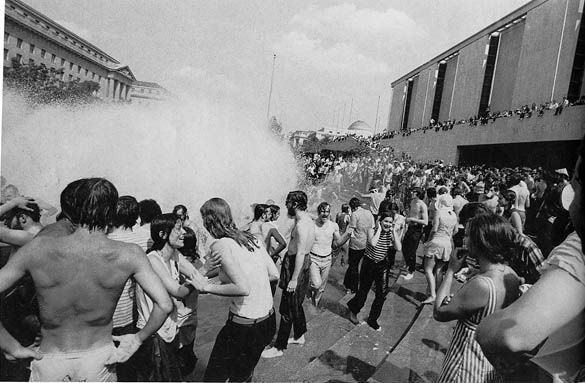 >
>May 09 2010
May ’70: 9. Violent Backlash
I was there when the reactionary “white terror” kicked in.
After the Kent State shootings, a New York City-wide demonstration had called for Wall Street on Friday-that was 40 years ago today, on Friday, May 8, 1970. I have no idea who called the demo, though it targeted the financial center of US capital and was around the three demands: US Out Of Southeast Asia, End Campus Complicity With The War Machine, and Free Bobby Seale And All Political Prisoners.
A small crew of us from NYU Uptown were there-I can’t swear to it, but I think it might have been Lon E. Bich and maybe Jim Bean. I remember the big banner for Bobby, and I remember how many high school kids seemed to be in the crowd of a couple thousand, crammed into the narrow streets of downtown Manhattan.
Suddenly, just before noon, as Wall Street types on lunch further crowded the area, there was a big stir about 20 feet from us. A tight column of dozens of guys wearing construction helmets with a couple American flags was wading through the crowd. Almost immediately it became clear that they were not just pushing protesters out of the way, but slugging them, beating them to the ground and kicking them. (Some Wall Streeters helped the injured. More joined the attacks.)
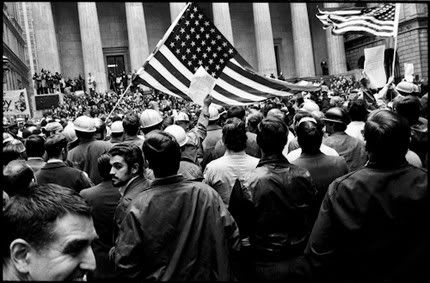
May 07 2010
May ’70: 8. Memory Loss
The sign was hung out of an NYU dorm window. It read, simply
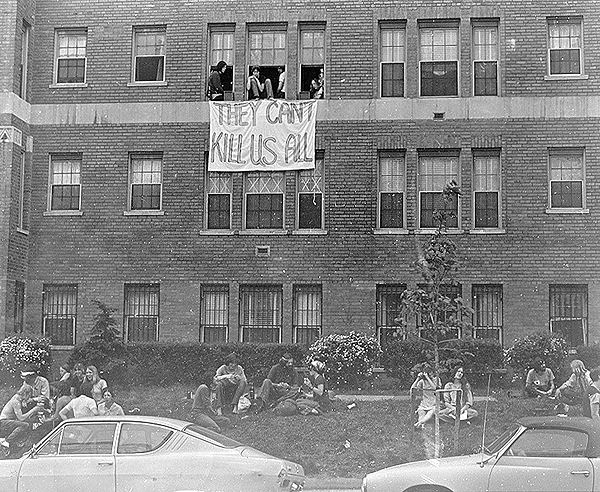
I want to use that sign as a starting point in talking about some largely unsuccessful emotional archaeology I’ve been doing, trying to reconstruct what it felt like to be 20 years old and a revolutionary in the midst of the first national student strike the country had ever seen.
I know I wasn’t expecting to be killed, even though–forty days ago today-the Kent State murders were only two days in the past and in the forefront of everyone’s thoughts.
And that wasn’t what the dorm room sign was about. Those kids didn’t expect to be killed either. They were celebrating the fact that the scope of our movement, the hundreds of new campuses-including high schools-which had gone out on strike since May 4 had pretty much removed violent repression as an option for the ruling class. I quoted John Kaye on the intensity of those days in yesterday’s installment. I’ve recently spoken with Mirk and Mindy, who, like me, came out of NYU and we all agree that there is a lot, a surprising amount, from these intense weeks that we just don’t remember.
May 06 2010
May ’70: 7. How Can You Run When You Know?
May 5th, 1970. As Tuesday dawned, the whole country, the whole world, knew about the Kent State massacre. The famous photo of Mary Ann Vecchio on one knee, keening over the body of Jeffrey Miller, snapped by a Kent undergrad seconds after the National Guard ceased firing on Monday, went on the Associated Press newswire that afternoon and was seared into the nation’s consciousness the next morning.
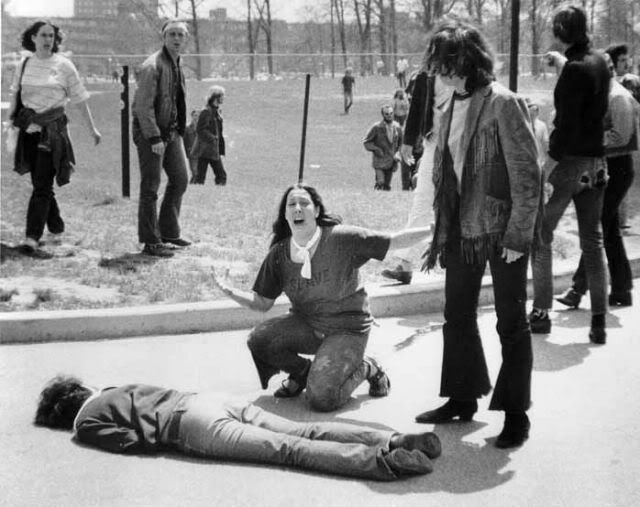
Chip Young, one of several friends who volunteered memories when I started this project, recalls:
I would have been 11. I remember my older brother informing my mom about the killings. Her response: “Oh no, not in America.” Perfect moment of shattered idealism.
Nan Faessler blipped me a single sentence:
Because of the killings at Kent State, I made a decision to drop out of graduate school and devote my time to working with the anti-war movement full time.
John Kaye’s response:
I never went to college, but at the time was living near Marquette U in Milwaukee, working in a Movement bookstore. What the right wing at the time used to call an “outside agitator.” Even before the invasion of Cambodia, at that point in my life activism was everything.
When the news hit, especially about Kent State, and shortly after, about Jackson State, things sort of…exploded. I didn’t sleep for 3 days, up all night at meetings, silk-screening clenched fists on t-shirts, etc. Demonstrations and whatever else we could think of all day and evening. The only time in my life I ever gave an impromptu speech, to a smallish group of students gathered just south of the campus, about the Panthers, I think.
In these three brief recollections, we see events as they actually unfolded–shock, individual commitment to resist, escalation of the struggle.
May 05 2010
May ’70: 6. Four Dead In Ohio
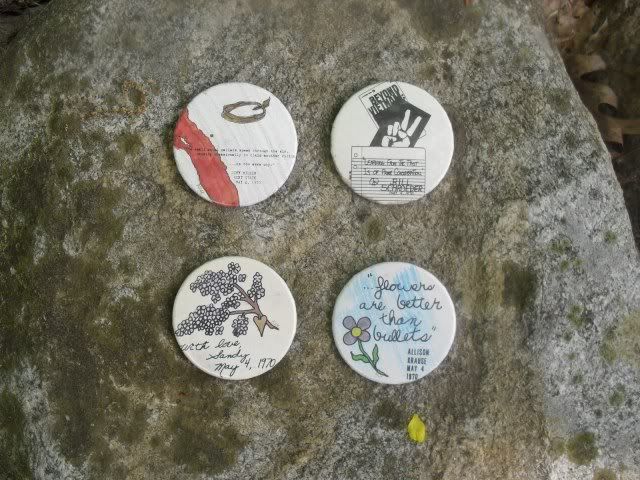
Handmade pins from the anti-gym struggle at Kent State, mid-70s
May 4 fell on a Monday in 1970.
At some point during the morning, four students each woke up, grabbed a toothbrush, maybe showered, got dressed, probably had a bite of breakfast, and headed out.
It wasn’t the proverbial day like any other day. For one thing, over the weekend National Guard troops had occupied their school, Kent State University.
Bill Schroeder and Sandy Scheuer both made their way to their first classes anyhow. Alison Krause figured she’d hit the big anti-war rally scheduled for the Commons at noon. So did Jeffrey Miller, despite the spreading reports that Kent State administrators planned to ban it.
At 12:24, they were flung into history.
May 04 2010
May ’70: 5. The Gathering Storm
May the Third, 1970 was a Sunday.
The main thing about it was that we still really didn’t quite have a handle on what was happening. Not did we know what was about to happen. Those who had spent years fighting campus battles–or who felt ourselves part of the broader multifaceted forces of social justice generally known as The Movement–were pretty much as full of excitement and uncertainty as the high school sophomore who had suddenly decided that she would cut school on Monday and head on over to see what was happening at the local college.
With the benefit of hindsight, of course, we now know that forces were gathering which would only one day in the future recast everything that had happened so far and intensify it by an order of magnitude.
What were we doing on May 3?
Though Students for a Democratic Society was gone, and with it any chance of real national leadership and coordination, it would be wrong to overestimate our isolation. Local successor groups and semi-formal regional networks were solidly in place in many parts of the country.
The first thing we did was share information. That was harder in the pre-Internet days, but every nugget plucked from a high school classmate or sib who had gone to a different school halfway across the country, every report from the radio, the teevee or the newspaper, circulated immediately.
And we networked. 20 campuses in the mid-Atlantic area had representatives at an emergency meeting at the University of Pennsylvania to coordinate strike activity.
And we organized. In the Boston area alone, organizers at M. I. T., Harvard. Tufts and Boston University were building for mass meetings on Monday to vote on strike proposals, while students at Brandeis met in their dormitories on the 3rd to decide what action to take. More than a dozen campus newspapers around the country endorsed the demands coming out from New Haven rally two days before.
[Interestingly the article from the Harvard Crimson dated May 4, 1970 where I found some of this info reported 1. that a “National Strike Committee” had come out of the May Day rally in New Haven and 2. that there was a fourth demand, Impeach Nixon. A good call, history would prove, but I don’t remember it myself, and for sure it was not on the semi-canonical 11×17 black on yellow strike poster.]
May 03 2010
May ’70: 4. The Eruption Begins!
In the previous installment of this growing May ’70 retrospective (criminy, can this be installment four already?) I wrote about being at the New Haven rally for Black Panther leader Bobby Seale on May Day and the call that the assembled demonstrators issued for a national student strike in the wake of Nixon’s invasion of Cambodia.
Thus armed, the NYU Uptown contingent headed back to campus on Saturday, May 2, to start organizing the strike. Imagine our surprise–half delight and half chagrin–when we found out that the despised campus liberals (like the student government types headed for law school and a career in the Democratic Party) already had it taped!
May 02 2010
May ’70: 3. May Day & Bobby Seale
Me, I don’t have much memory of Nixon’s April 30, 1970 speech announcing the invasion of Cambodia. It could have been because nothing the bastard did would have surprised me by that point, but more likely it’s just that I was already on my way to New Haven to see about Bobby.
That would be Bobby Seale, chairman of the Black Panther Party, who was facing trial in the case of some Connecticut Panthers accused of murdering a member they thought was a police informant. A national call had gone out for a May Day demonstration to defend Bobby, and thousands of young radicals from around the country and especially the Northeast were en route. We had a couple of dozen from NYU’s Uptown campus with us.
Lemme step back here to set a little context. NYU today is a bigtime, self-promoting academic powerhouse whose relentless pursuit of lower Manhattan real estate for expansion has earned them the hatred of all clear-thinking New Yorkers. Back then, NYU was a bit cheesier, with a campus in Greenwich Village and a satellite one in the Bronx. (The Uptown campus was abandoned by the racist NYU administration later in the 1970s when it found the West Bronx was becoming, let’s say, too colorful, and is now the home of Bronx Community College).
We had a pretty good SDS chapter at NYU Uptown and saw no reason to change anything just because the national organization had imploded the previous summer. (In fact, at one point we decided the chapter head, Lon E. Thud, must be National Secretary of SDS-nobody else was doing it, after all). NYU had given me a “compulsory leave of absence for academic reasons” at the end of the previous school year, a tactical mistake on their part. I was still a registered student and, as such, could not be excluded from the campus.
May 01 2010
May ’70: 2. Nixon Kicks It Off!
I want to continue this review of May, 1970 with a deeper look at Richard Nixon’s speech, broadcast 40 years ago tonight. It was that speech, announcing that US troops were invading Cambodia, which triggered the eruption of protest that was May 1970. Actually, you could say Tricky Dick predicted it:
My fellow Americans, we live in an age of anarchy, both abroad and at home. We see mindless attacks on all the great institutions which have been created by free civilizations in the last 500 years. Even here in the United States, great universities are being systematically destroyed.
The US High Command had known since 1967 that the Vietnam War was unwinnable, as the leaked Pentagon Papers later showed. Nixon had been elected in 1968 with the promise that “new leadership will end the war” and giving wink-and-nod no-comment replies to reports he had a “secret plan” to do so.
Apr 30 2010
May ’70: 1. Finally On Our Own
Tin soldiers and Nixon’s coming, We’re finally on our own… Forty years ago today, on Thursday, April 30, 1970, Richard Milhouse Nixon, the president of the United States, appeared on television for a special announcement about the Vietnam War. He told us that US troops, tens of thousands of them, had moved into Cambodia, expanding an already prolonged and costly war into another country. He claimed it was a necessary step toward ending the war, and toward insuring that the US would not be perceived in the world as “a pitiful helpless giant.”
Today that incredible upsurge, which pretty much shut down the 1969-70 school year throughout much of the American higher education system, is remembered mainly through one of its most dramatic events–the killing of four students at Kent State University by a sustained fusillade of gunfire from Ohio National Guard troops occupying their campus.
For forty years, the veterans of those days and younger activists have struggled to keep alive the memories of Kent State and of the subsequent police murders of two more students, this time at a traditionally Black college in Mississippi, Jackson State. We have succeeded in this, helped in part by that amazing mnemonic, Neil Young’s heartbreaking song, “Ohio,” which opens with the couplet at the start of this piece.
